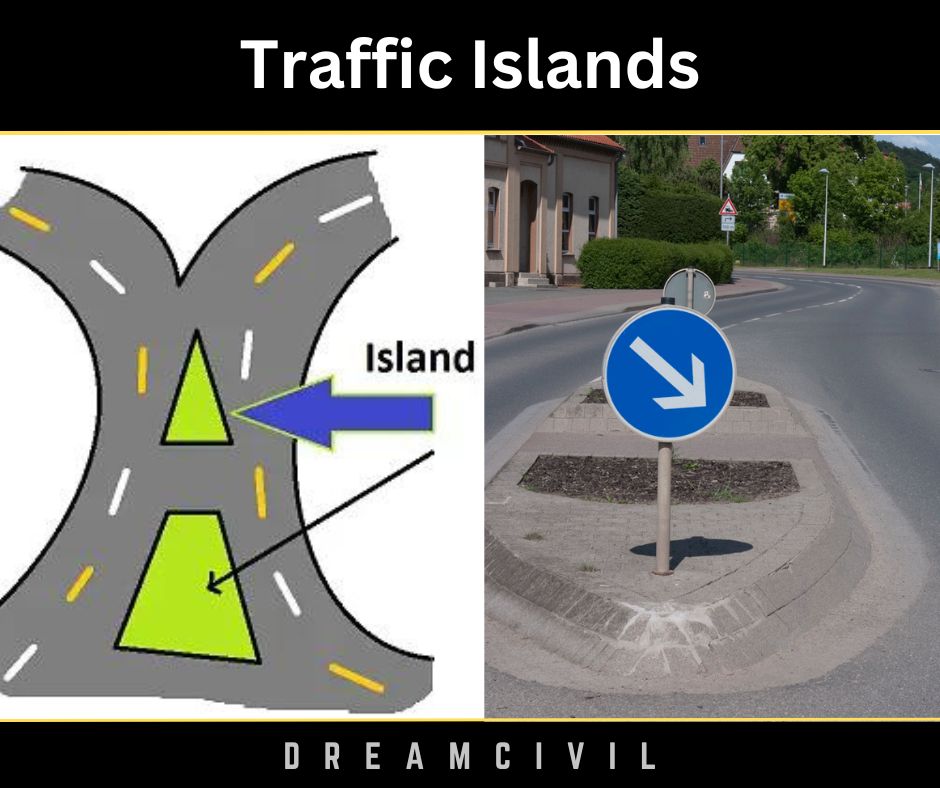Table of Contents
What is Traffic Islands?
Traffic islands may be defined as an area between traffic lanes for control of vehicle movements. An intersection area’s median or outer separation is regarded as an island. They minimize regions of considerable and minor conflict.
The island shows physical channels through which vehicular traffic may be directed to travel and neglect conflict. There are different types of traffic islands available.

1. Types of Traffic Island
Traffic islands usually serve more than one function but maybe generally classified into four separate types:
1. Channelizing Islands
2. Divisional Islands
3. Pedestrian Islands
4. Rotary Islands
1. Channelizing Islands
These are planned to handle and direct traffic movement, mostly in turn. They are convenient for intersections at grade, especially when the area is extensive. The size and shape of the channelizing island will differ depending on the layout and dimensions of the intersection.

2. Divisional Islands
These are planned to separate opposing or same-direction traffic streams through movements.

3. Pedestrian Islands (Refuge Island)
Pedestrian islands are provided to operate as safe zones for helping and guarding persons on foot. If a divisional island is encountered in an urban area where pedestrians are attending, pieces of each island can be regarded as a refuge island.

4. Rotary island
This is the big central island of the rotary intersection. This allows to transform crossing maneuvers to weaving by delivering adequate weaving length.

2. Design Considerations for Traffic Islands
The whole design of traffic islands can be performed in three stages:
A. Selection of Appropriate Island Type
Each intersection’s site and traffic requirements vary, so the island type appropriate for each needs a particular concentration.
The traffic island fixed varies from barrier-type islands to flush islands observed on the roadway surface.
B. Determination of the Shape and Size of Islands
We must evaluate the size and shape of the traffic islands that will be constructed on the road. The role of each traffic island is specified by its size and shape. A median traffic island is a traffic island that is more extended than wide. Its role is to separate traffic flow.
A channelizer contains a traffic island that heads traffic in one direction. A rotary traffic island can be available round or circular as it revolves. The ring delivers drivers more maneuverability.
C. Location Relative to Adjacent Traffic Lanes
The islands must be offset from the roadway by a few distances to clear the danger of a vehicle running against the same. The width of the offset is greatest at the island’s entrance and drops slowly as one moves toward the end of it.
3. Function of Traffic Island
The function of Traffic Island is as follows:
a. They separate vehicular traffic from walking people.
b. They decrease the conflict spots.
c. They separate traffic into specification paths.
d. They improve traffic safety.
e. They improve the traffic capacity of the road.
4. Advantages of Traffic Islands
The advantages of Traffic Islands are as follows:
a. The one-way movement delivers orderly and disciplined traffic flow.
b. Regular stopping and starting of automobiles are bypassed.
c. Direct conflict is stopped.
d. All turns can be completed with comfort.
e. For medium traffic, rotaries are self-governing and require no supervision by police or traffic signals.
f. The capacity of rotary islands is the highest of all other islands.
5. Disadvantages of Traffic Islands
The disadvantages of Traffic Islands are as follows:
a. It needs large of land. So where space is limited and costly, the whole cost may be increased.
b. Where pedestrian traffic is influential, the islands cannot handle the traffic and requires control by traffic police. If the vehicular traffic has to stop to permit the pedestrian to walk, the immediate use of the islands has defected.
c. At locations of mixed traffic, the design of the island evolves too complicated, and the operation and control of traffic evolve problematic.
d. A Islands becomes problematic when the length between the intersections on important highways is less.
e. At places of mixed traffic, there is a proneness to violate the traffic law of clockwise movement.
f. Where the traffic volume is insufficient, making a rotary cannot be explained.
6. References1. Content Filter & Authenticity Checking Team, Dream Civil International (Our team checks every content & detail to maintain quality.) |
Read Also: Consolidation of Soil

